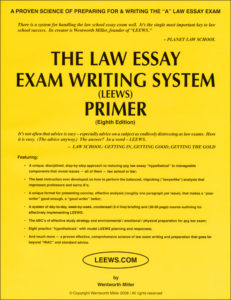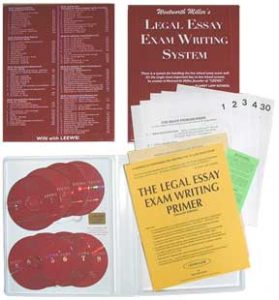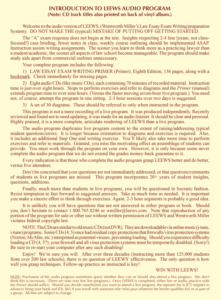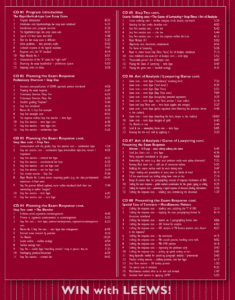(also cost/registration/order information)
LIVE PROGRAM or equally effective AUDIO CD PROGRAM
| Where all others offer mere IRAC and helpful hints, we offer a tested, proven effective (over 30 years!) science of preparation and exam writing. |
- Live One-Day Program
- Registration (individual, group, cost)
- LEEWS Book (Primer) – photo and description
- Audio CD program
The Live, One-Day Program
(Content duplicated in the equally effective audio CD program described below)
Learning the many facets of the LEEWS system takes a full day (7 hours + lunch) and practice afterward. LEEWS is not about shortcuts, tricks, and quick fixes. We definitely make law school easier in the sense that knowing exactly what you are about makes something easier. Many of our students say they begin to enjoy law school. However, law school and law school exams present a significant intellectual challenge. New ways of thinking and new organizational strategies are required. Hard work is required. There is much to learn and master. Therefore, anything less than our full, rigorous, but surprisingly enjoyable day (e.g., the chatty, free, 45 minute examsmanship program sponsored by bar exam giant, Bar-bri, and formerly conducted by Professor Charles Whitebread, that may be offered in your law school [critiqued in Standard Advice Free!]) necessarily offers but a minimal exposure to the WHAT of what is needed IRAC and helpful hints , but hardly a thoroughgoing inculcation of the precise HOW of performing necessary skills and implementing successful strategies.
In a 8:45-5 p.m. program, normally held in a hotel, Wentworth Miller, LEEWS founder [See About Your Instructor.], combines lecture, exercises, and class participation in a surprisingly entertaining mix to instruct and inculcate the unique, proven effective LEEWS approach to preparing for day-by-day, week-by-week through the term and taking ANY essay hypothetical-type exam (made up story fact patterns). You learn the following and more:
Issue identification system
The name of the game on law school essay exams is often said to be “issue spotting.” Yet it is never made quite clear by professors or other study aids what, exactly, an “issue” is. (See, e.g., the critique of professor Whitebread’s [Bar-bri lecturer on exam writing] discussion of “issue” in Standard Advice Free!) (LEEWS is very precise in defining “issue.” Suffice for now that “issue” means a legal question or topic prompted by the fact pattern [“hypothetical”] that a competent lawyer, knowledgeable in the subject being tested [e.g., property law, contracts, etc.] would deem relevant to explore.)
Since they are unclear about what “issue” means, it should not surprise you to learn that professors and others purporting to offer exam writing instruction offer a less than precise strategy for identifying issues lurking in complex fact patterns. They instruct “issue spotting,” but it turns out to be a haphazard approach. Indeed, the very term “issue spotting” implies a haphazard approach. “Checklist” in hand (of legal rules, concepts, etc.), you (typical approach) plunge-into-the-facts-to-find-what-you-can. You’ll continue to be confused and anxious as you confront new and unpredictable fact patterns and essay exercises.
Nearly 30 years ago Wentworth Miller, attorney, Yale law grad (’77), Rhodes scholar, developed a 3-step process for breaking ANY fact pattern down into units, much as an attorney in practice would. The units reveal relevant issues all of them!
Applying the Steps eliminates the uncertainty most law students experience when confronted with a typically chaotic hypothetical fact pattern. You immediately take control of any hypothetical, not the other way around. Practice is required. Confidence going into any exam is assured.
“Lawyerlike analysis”
This refers to the nitpicking, balanced, reasoning dialectic between law and facts that is critical in impressing professors and earning A’s. It is THE ESSENTIAL SKILL FOR SUCCESS, and most law students (including 2 and 3Ls at Harvard and Stanford) never get good at it in law school. Thus, they have no prospect of writing an “A” exam (!!).
[Unless and until you become adept at lawyerlike analysis, you can’t “learn the law” properly (i.e., learn to use it as a tool, apply it to facts, as lawyers do). Add to this confusion over identifying issues, inability to present concisely, time pressure, etc. (none of which is adequately addressed in law school), and it becomes understandable that over 80 percent of law students (even at Harvard) never write an “A” essay exam not one! Most law students merely survive exams.]
The good news is that lawyerlike analysis is a skill that can be learned. The bad news (actually also good news for LEEWS grads) is that law schools and the case method do a poor job of instructing lawyerlike analysis which is why so few law students come close to writing “A” exams.
While our issue identification and concise presentation approaches are highly innovative and effective, it is likely our skill in instructing the lawyerly art of analysis that most sets LEEWS apart from all other exam writing aids, and gives our students their greatest advantage. Often students say they weren’t able to apply the LEEWS approach meaning the issue identification steps on a particular hypo (fact pattern), yet they got an “A.” Why? … Because their analysis impressed and set their response apart. [We must note that they should have been able to apply the issue identification approach. Once understood and practiced, it works for ALL hypos in ALL exams. They just hadn’t gotten good enough at it. Nevertheless, their superiority at analysis still made the difference.]
Hands on, you learn how to “play the game” how to analyze as a lawyer would, how to get analysis down on paper concisely. 15-20 minute exercises after class (3-4x a week) will rapidly develop this critical skill.
Once you learn how to analyze as a lawyer, how to apply rules and principles to facts, formulating insightful arguments for and against aspects – elements – of the rule/principle whose applicability is at issue, everything falls into place what you want from cases, how you need to learn the law, following class discussion with far more useful thinking (about the law and its application) and far less wasteful scribbling of notes, where policy considerations come into play, constructing a useful course outline, etc.
Presentation on paper
Equally innovative and confidence inspiring is our format for presenting analysis in a series of concise paragraphs (roughly one per issue). We basically take “good writer” out of the equation, because we turn presenting analysis concisely almost into a mathematical formula. “IRAC,” merely a format for ordering the discussion (e.g., state the Issue, state the applicable Rule [of law], Analyze, Conclude), and the how of “follow IRAC,” “IRAC my exam,” is finally understood.
Preparation
Time-consuming case briefing, even “book briefing” (i.e., highlighting rule, facts, “holding,” etc. in the casebook, and making notes in the margins) is out! (You don’t want to have to re-read cases.) You learn to extract only what is relevant to the exam (“tools”) from cases and take fewer notes in class. You learn how to build, day-by-day, week-by-week (or, if need be, within a matter of days), a course outline geared to implementing the LEEWS issue identification approach on all-important final exams.
Typically, our students brief cases in 2-4 lines, take less than a page of notes per class hour, and outline entire courses in 30-50 pages, and often less (10-12!). How is this possible? Briefly, when you learn to properly think about the law and its application (using the legal tool, the analysis described above), you’ll retain more and longer, because it’s fixed in your mind by use and association (versus rote memorization, which is typically short term). Then you need only write down enough typically a few salient facts to jog recall of what’s now firmly anchored in your memory.
It’s a full day, but your seasoned instructor makes it surprisingly enjoyable. Mastery requires moderate practice. Preparing for and handling any exam in any subject becomes a predictable process. You’ll gain an immediate sense of confidence.
Individual Registration:
COST: $135 (includes book depicted following), if payment made by Wednesday prior to date of program [actually prior to 9 a.m. EST start of business on Thursday]. $150 afterwards and at the door. You can register online with a credit card (VISA, MC, AMEX, DISC.), through the mail with check, money order, or credit card, or over the phone with a credit card (1.800.765.8246). All forms of payment, including cash, are accepted at the door. See Live Program for further information.
GROUP RATES: 3-6 = $120 (INCLUDES BOOK); 7-12 = $115; 13+ = $110 (OR the organizer of a 13+ group may attend free [!!]. However, group members would pay $115, not $110, and must be informed of this.) Groups may form at any time prior to a live program (even by calling in the name of the group and the names of members by 7:30 a.m. the morning of the program [!!], although we would prefer to know about groups in advance to insure sufficient materials. Persons already registered individually may join of form a group at any time up to 7:30 a.m. the day of the program, and their payment will be adjusted accordingly. See Live Program for further information on groups and group formation.
The Primer alone may be ordered for $45, which includes priority mailing and handling through the post office. However, it is apparent from many years of experience that it is extremely difficult to pull LEEWS out of the book on your own.
It is not that the book is incomplete. After seven revisions it is very complete. However, the many facets of the approach, the newness and unfamiliarity of the constructs and process it is unlikely that you will commit yourself to the effort required to grasp LEEWS from the book alone without more assurance that the effort is worth it. The purpose of the live and audio programs is to guide you through the system, provide an immeidate sense of its effectiveness. Then the book is useful as a reference, a refresher.
Should you later decide to attend the live program or purchase the audio program, a $15 credit for having the Primer will be given toward the cost of the live program, a $25 credit toward purchase of the audio program.
[See Primer Excerpts, Table of Contents for additional overview.]
Audio CD Program
[LEEWS note: You have a ten day free trial of the audio program.]
| Even though you don’t get [the money back guarantee] if you acquire the [LEEWS] program on tape, I still believe the tapes [now CDs] are the better way to go. PLANET LAW SCHOOL (p. 91) |
The audio program duplicates, but is not a mere recording of the live program. It was produced in a sound studio from a transcript with an audio listener in mind. If anything, the audio program is more complete and articulate in setting forth LEEWS than the live program. You’ll feel as if you’re attending live, but you work at your own pace. THERE IS NO DISCERNIBLE DIFFERENCE IN EFFECTIVENESS BETWEEN THE LIVE AND AUDIO PROGRAMS IF YOU TAKE THE TIME TO DO IT (!!). However, because we have no control over the use to which the audio program is put (e.g., some students don’t go through it, or only partially), the money back guarantee does not extend to the audio program. Share the cost with a friend!
Audio versus Live Program
Purchasers of the audio program typically say they “like it very much,” and “it is better than I expected.” Fewer than 1 in 50 take advantage of the 10 day free trial policy and return the program. (It’s that good!) Many of these purchase the program late in the semester and decide they cannot devote sufficient time to go through it which is a mistake. Even in the final days before an exam LEEWS can make a significant difference.
More so than the live program, the audio program is interactive. Socratic questions posed to the live audience at large are posed directly to the listener. There are frequent references to diagrams and portions of the LEEWS Primer. The listener stops to address a question or look at a diagram or portion of the Primer, then proceeds. Where the live attendee may miss a point or reference, and the class moves on, the audio listener can run the tape back and take as long as needed to fully digest the exercise.
The current audio program was produced after 24 years experience conducting the live program. The questions live attendees ask at various points, the responses and missteps on exercises, etc. are well known. They are set forth in this fourth version of the audio program. A 2011 review of the audio program indicated no need for a new version. The audio listener gains an accurate sense of what is going on in the live program, including breaks. She performs the same exercises, but has more time. Not surprisingly, the diagrams are more complete than those executed during the faster paced live program. Certain subjects e.g., application of LEEWS to contracts – are covered in somewhat greater depth.
Some individuals, of course, simply don’t work well on their own with CDs, diagrams, and a book. We think that once you get started, the newness, insightfulness, and obvious effectiveness of the information conveyed is sufficiently compelling to keep you going. However, there is no question but the live program is more energetic, and a live participant tends to be swept along with the group. The no questions asked, full refund, 10 day return policy is your insurance policy should such prove the case.
Three letters expressing reactions to the audio program follow. Additional reactions are in the Results section.
[An e-mail from a Cornell 2L who took the LEEWS audio program first term]
Howdy:
I’ve already started recommending [LEEWS] to people. I ended up at the top of my class last year, made law review, and have interviews, callbacks, and offers for employment from the best firms in the country. So I’ve been telling all the 1Ls in my section [in which I am a T.A.] about the benefits of actually knowing how to take a law school exam.
Feel free to refer anyone here at Cornell to me if they have questions about the program and its benefits.
Studying definitely played a large role, but the help from LEEWS was invaluable in helping to aid that studying. I came to Cornell from a school that was not a top tier undergrad [George Washington], and certainly one of the lower ranked schools represented at Cornell. To do so well is a testament to LEEWS, and how it helps people sift through the multitude of material that one learns at law school and get to the meat that professors really want to see on an exam. I fared far better than I ever expected, and it has opened up far more opportunities than I ever thought possible.
Thanks again so much, and if there’s anything I can do, let me know.
Best, Sean Akins ’07
[Someone who used the audio program right from the beginning.]
Dear Mr. Miller [LEEWS founder]:
I am writing to tell you how much I appreciate the LEEWS system. Like most first year law students, I was somewhat neurotic about grades. So when I found LEEWS on the internet, I decided to give it a shot. I purchased the LEEWS audio cassettes last summer, before my first year began. I tried to apply the principles throughout the year. As the first semester progressed and I began to see what professors wanted, I realized that LEEWS was really going to work. I was pleasantly surprised to find that I ranked 2nd at the end of the first semester. I am certain that I would have been 1st after the second semester, but I did not use the system on a final ( I thought that I could beat the professor at the silly little game she likes to play on finals, but it backfired, and I would have been much better using LEEWS). I got a significantly lower grade in that class, but I still ended up 5th out of 152 students.
LEEWS was truly a Godsend. I know that I could not have performed this well without your system. It is remarkable how much the system reduced my stress and allowed a person of average intelligence to excel on such difficult exams. I believe that it is invaluable to know what professors want and to have a plan that will allow you to wade through their garbage and give it to them.
After the first semester, I told my friend about it. Only one bought it, and he did not start on the program until late in the semester. LEEWS did not help him as much as he would have liked, but he knows that he can do much better next semester if he uses it all semester. One of my other friends asked me about it after his second semester grades disappointed him again. He realized what I had already discovered: LEEWS is by far the best investment that a law school student can make. It is strange that we pay so much for law school and for only a hundred dollars more [$95-115 for the live program($130 after Wednesday prior deadline), $145 for the audio program] we can actually learn how to succeed in law school.
Sincerely, Gabe Clark ’01, Brigham Young University Law School
[Someone who got the audio program as a 2L.]
Dear Mr. Miller:
I ordered your tapes in September, listened to them, and practiced your techniques. I was stunned! Before this past semester, I had taken 10 classes (the first year core). Only two grades were above 80 percent, the highest being an 84. After listening to the tapes, the lowest grade I received was an 82 in Constitutional Law II. The remaining grades were a 92 in Community Property, 89 in Judicial Remedies, an 87 in Evidence, and an 84 in Criminal Procedure. These grades are proof that LEEWS is a remarkable breakthrough in improving test taking strategies in law school. In four of five classes my exam grade was one of the top seven the professor issued.
Sincerely, Scott Hyder ’92, Arizona State U. College of Law
[Note: Despite the effectiveness of the audio program for Mr. Hyder, he expressed concern that it dated back to 1986. A second version was produced in 1995. A third version was produced in 2000. The current and fourth version, produced in 2004 and now in CD format, is the most complete and articulate version of LEEWS ever. For a more complete text of Mr. Hyder’s letter, as well as reactions of other audio program purchasers, see the Results section.]







